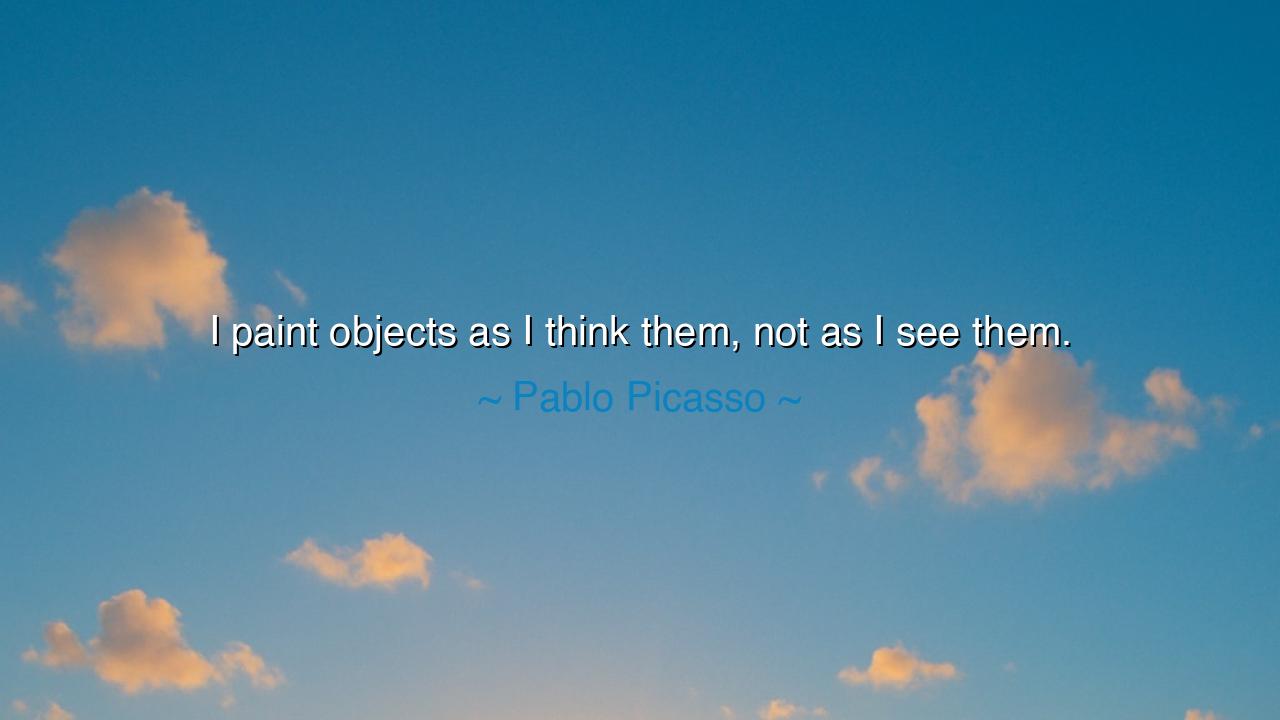
I paint objects as I think them, not as I see them.






“I paint objects as I think them, not as I see them.” Thus declared Pablo Picasso, the visionary who broke the chains of convention and redefined the very nature of art. In this bold proclamation, Picasso reveals the essence of creation — that the true artist does not merely reproduce the world as it appears, but interprets it as it is felt, known, and imagined. To see with the eyes is the beginning of perception; to see with the mind is the birth of art. His words echo the wisdom of the ancients, who taught that sight alone perceives the surface, but thought perceives the soul.
In the origin of this statement lies Picasso’s rebellion against realism, his defiance of the belief that art must mirror the visible world. In his youth, he mastered traditional painting with astonishing skill — he could render the human form with precision beyond his years. Yet he soon discovered that truth in art is not found in imitation, but in vision. He saw that the eye deceives, binding us to appearances, while the mind liberates, transforming what is seen into what is understood. Thus was born his revolutionary approach — Cubism — where the world is broken into fragments and reassembled through the inner logic of the soul. He was not painting faces and objects as the eye captured them, but as consciousness experienced them — from many angles, in many moments, as living ideas rather than lifeless images.
When Picasso said he painted as he thought, not as he saw, he was expressing a principle that transcends art — a truth about human perception itself. What we see is only a small portion of reality; the rest must be imagined. The visible is a veil, and behind it lies meaning, memory, emotion. The wise understand that to grasp the essence of anything — a person, a dream, a world — one must go beyond appearance and enter the realm of interpretation. Picasso painted what the philosopher might think, what the poet might feel. In his canvases, the external form dissolves, and what remains is spirit — raw, mysterious, and eternal.
Consider how this principle lives in the story of Vincent van Gogh, who painted fields not as they looked, but as they moved within him — alive with motion, trembling with color, heavy with emotion. The wheat fields, to the eye, were golden and still; to his heart, they were a symphony of sorrow and fire. He, too, painted as he thought and felt, not as he saw. Thus his art, once mocked for its distortion, now speaks to generations as truth — not the truth of the photograph, but the truth of the soul. Both van Gogh and Picasso remind us that art’s highest calling is not to copy life, but to reveal the inner life of the mind and heart that perceives it.
Picasso’s teaching also speaks beyond art, to the creative spirit in every person. For each of us, whether we hold a brush or not, lives within two worlds — the world we see, and the world we conceive. The first is bound by the senses; the second is boundless, shaped by imagination and thought. When one acts only according to what is seen, life remains shallow, mechanical, repetitive. But when one acts according to what is felt and envisioned, life becomes creation itself. To think beyond what is seen — to shape the world according to the image within — is the work not only of artists, but of dreamers, leaders, and visionaries in every age.
And yet, there is great courage in this way of seeing. For to think differently, to paint differently, to live differently — is to walk the edge between understanding and madness. Many mocked Picasso, as they mocked all who dared to remake the world in their own image. But he stood firm, guided not by sight but by vision. His art asked the world to look again, to see not with the eyes alone but with the mind’s deep knowing. For in that deeper seeing lies freedom — the freedom to define, to create, to transform reality itself.
So, my listener, learn from Picasso’s wisdom. Do not be content to live as one who merely sees; live as one who thinks and imagines. When you behold the world, ask not only “What is there?” but “What does it mean to me?” Paint your days with the colors of your thoughts, your dreams, your unique perception. Whether your art is in words, work, or deed, let it come from the inner vision that transcends the obvious. For the eyes show only the form — but the mind and heart reveal the truth. To live as Picasso painted is to live as a creator: to shape your world not by what is given, but by what you dare to imagine.






AAdministratorAdministrator
Welcome, honored guests. Please leave a comment, we will respond soon